In the ever-evolving digital marketing landscape, every business is constantly seeking ways to optimize their online marketing efforts. From click-through rate to customer acquisition cost, every advertiser works precisely to maximize advertising ROI. Target ROAS is one such Google Ads metric that has gained prominence recently. It has enabled businesses to boost sales, attract traffic to the landing page and promote brand awareness in the competitive landscape. In this blog, let’s explore what Target ROAS is and how you can take its advantage to enhance the conversion rate for your business.
What is Target ROAS?
Target ROAS(tROAS) is a smart bidding strategy developed by Google. This bidding strategy analyzes and predicts the potential conversion value each time a user searches for products and services the business offers. Google's automated system optimizes bids during auction time, allowing users to customize bids for each auction. This implies that when the bid strategy predicts that user searches are likely to lead to high-value conversions, Target ROAS will increase its bid for those searches, and decrease it for those expected to generate less value. Consequently, Target ROAS aims to maximize the value derived from each conversion, rather than simply increasing the quantity of conversions.
What is ROAS?
Return on ad spend (ROAS) is an important key performance indicator (KPI) in online advertising. It tells the amount of revenue earned by the business for each dollar spent on PPC advertising campaigns. It is a crucial PPC metric for measuring the success of PPC ads, as ROAS provides a holistic overview of PPC campaign success.
In brief, it measures the effectiveness of advertising efforts. The more effective your ad campaign conveys messages to the target audience, the more revenue your ad campaign can generate from the amount spent on a PPC advertising campaign. Regularly monitoring PPC ad campaign performance can help measure its effectiveness. It will help you achieve your campaign's goals, like boosting brand awareness, lead generation, form-fill-up, etc. Also, by linking your Google Ads account with Google Analytics, you can analyze traffic sources and effectively target your ads to increase conversions.
Formula to calculate ROAS?
Calculating ROAS is pretty simple. ROAS equals the revenue generated divided by money spent on advertising multiplied by 100.
ROAS = (Total revenue/Total ad spend)*100
For example, You are running an online men’s clothes store, and you want to optimize bids based on the shopping cart total. Your goal is $ 3 worth of sales for each $ 1 spent on ads. Then your ROAS will be 300, which means you will like to get $3 in revenue for every $1 spent on advertising. ROAS = (Sales/Spent)*100 ($3 / $1)*100 = 300
Route to target ROAS
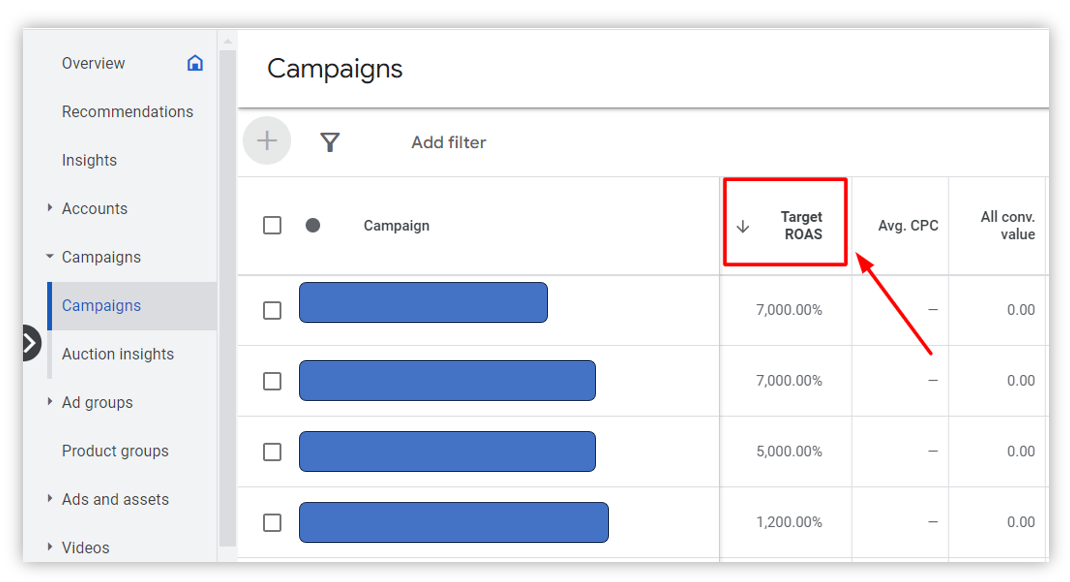
Smart bidding is a bidding strategy that uses Google AI to optimize the conversion value in every auction. Target ROAS, Target CPA, maximize conversion, and maximize conversion value are part of a smart bidding strategy. In order to understand Target ROAS, you need to understand other smart bidding strategies to enhance your PPC campaign performance.
1. Target CPA
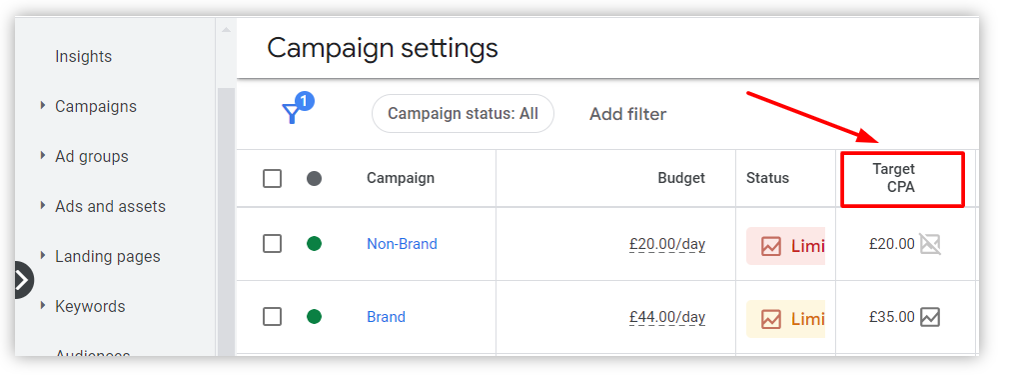
Target CPA or target cost per action is an automated bidding strategy that sets bids to get as many conversions as possible at your desired average cost per action. It is an advanced bidding strategy that uses machine learning to optimize bids and offer auction-time bidding strategies that modify bids for every conversion.
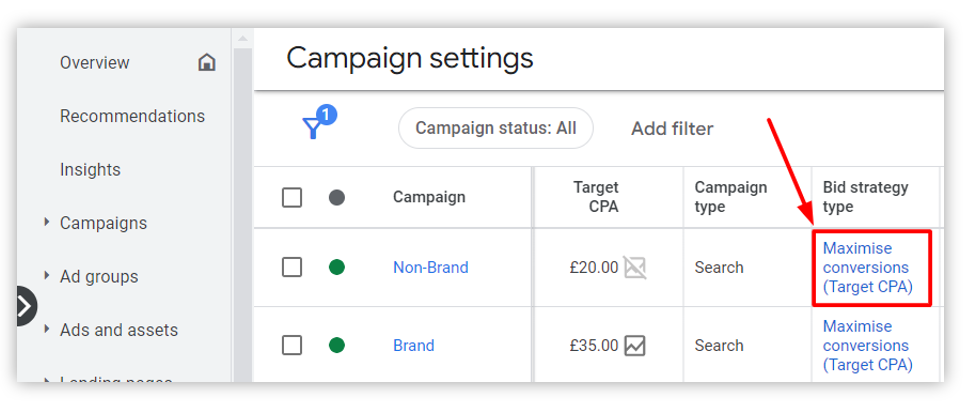
Maximize conversion is developed to get you as many conversions as possible within your advertising budget. This bidding finds an optimal bid for the ad every time it is suitable to appear by using past information about your campaign and assessing contextual signals present at auction time.
3. Maximize conversion value
This bidding strategy works similarly to the max conversion strategy, but it optimizes for conversion value instead of conversion volume. This means that it may bid higher for an auction, which would result in a greater conversion value as compared to an auction with a lower conversion value.
When should the Target ROAS bidding strategy be used?
Use Target ROAS when Google Ads drives direct conversion for your business.
1. For example:- You own an e-commerce shoe company and run PPC ads to boost sales of women's shoes. In such a scenario, tROAS is a suitable bidding strategy because it will optimize each PPC ad campaign to generate its desired return on investment. You can also consider outsourcing your e-commerce PPC services to experts who specialize in website conversion analysis. After analyzing the landing pages, the PPC experts can develop and implement effective planning and strategies to optimize the PPC ads.
Avoid using Target ROAS when Google Ads do not drive direct conversion for your business.
2. For example:- You work for a product-based company that wants to run local service ads to promote its brand in the local area. In such a scenario, you should avoid using the tROAS bid strategy. This is because direct conversion is not associated with your ad campaign objective.
How to apply Target ROAS?
Before applying the Target ROAS bid strategy in your ad campaign, you need to set conversion values.
Step 1:-Setting up conversion value.
In Google Ads accounts, you can assign conversion value to either existing or newly created conversion action.
a. Select the “Tools and Settings” icon in Google Ad accounts.
b. Select “conversion” under the measurement drop-down.
c. Then, create a new conversion or select the existing one you want to edit.
d. Go to the value section in the conversion.
e. Assign value to conversion. You will have two options to assign conversion. They are:-
i. Assign a fixed value for every conversion. For example:- if you sell only one type of product/service, enter the value for each sale.
ii. Assign distinct values for each conversion. For example:- if you sell multiple products/services at different prices, you can assign different values for each conversion.
Step 2:- Setting up Target ROAS Value

You will need to specify the percentage of return when selecting Target ROAS as your bidding strategy. There are certain factors you need to keep in mind when determining percentage. They are:-
a. Conversion value optimization for
b. Formula to calculate ROAS
c. ROAS doesn’t take into account that ROI does.
Average Target ROAS
Average Target ROAS is the traffic-weighted average of return on ad spend for which your bid strategy optimizes. This metric measures the ROAS of your targeted bid strategy set for a specific time period. The average ROAS is in the performance table of the “campaign” page. This metrics let you compare actual performance with the target performance of your ad campaign. Google advises tracking the performance and average goals of your campaign over a designated time frame. It is available for both standard and portfolio bid strategies.
Note:- This PPC metric is only supported for performance max, search campaigns and shopping campaigns.
Essential Target ROAS bidding requirements
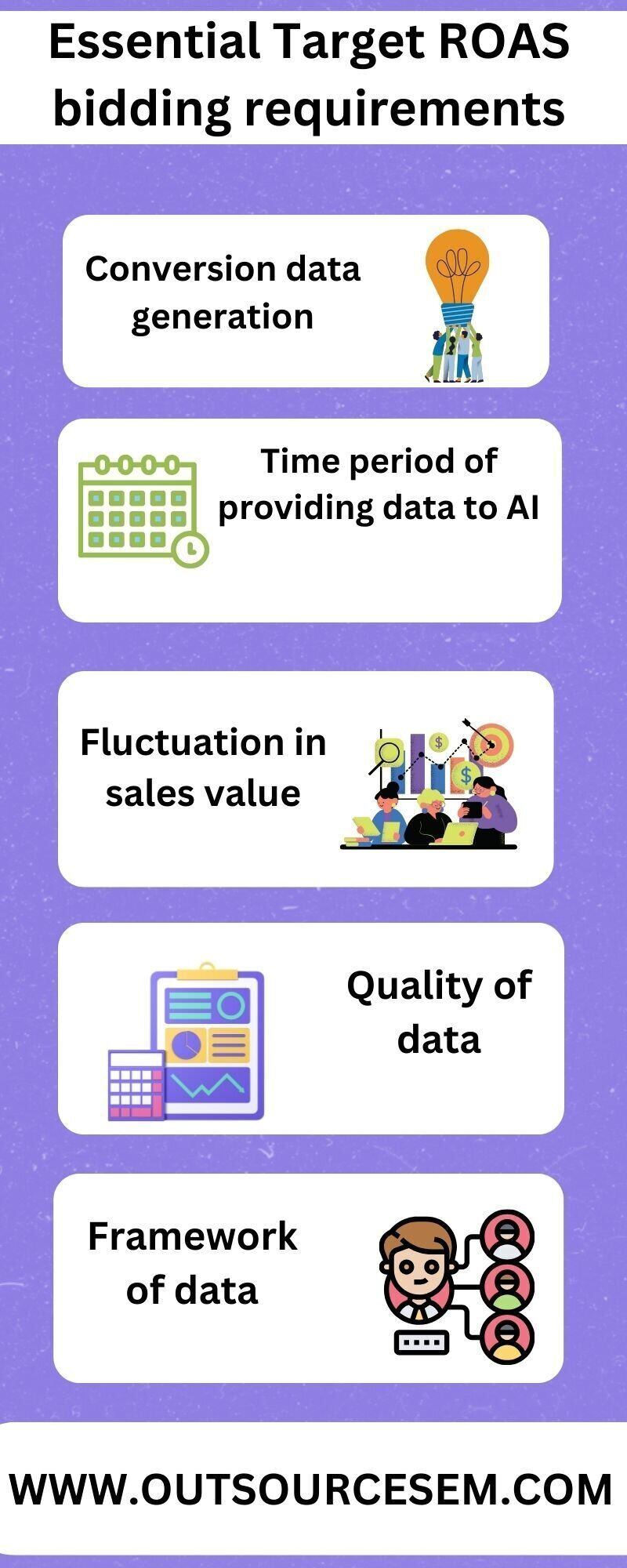
1. Conversion data generation
Before implementing the tROAS bidding strategy, it is vital to consider your business's monthly sales to gather sufficient conversion data. Target ROAS requires a minimum of 15 conversions in the last 30 days to provide Google with adequate data to make statistically accurate bidding decisions. This data allows Google's AI to analyze patterns, show correlation, and draw meaningful insights into fuel machine learning.
AI would compromise its predictive capability with insufficient conversion data that could hamper the aim of applying the tROAS bid strategy in an ad campaign. Larger data sets provide Google more opportunities to learn and bid more effectively. Different campaign types require different conversion data for effective Target ROAS. For a new campaign, start by maximizing conversion value, which has no requirements and in later stages, upgrade to Target ROAS after reaching the required threshold for prospective campaigns. Therefore, deciding sales figures to set Target ROAS is crucial.
2. Time period of providing data to AI
Your business's sales cycle determines the rate at which you can assign values to different conversions and provide data to Google. The sales cycle varies according to the industry you belong to. For a B2B company, the sales cycle is generally between 60 to 90 days. In B2C companies, the sales cycle is generally between a few days to a few weeks. Consider potential customers who clicked the ad and conversion event according to your business type. Please note conversion should occur within 90 days of clicking.
3. Fluctuation in sales value
Before implementing Target ROAS, one factor that you need to consider is a fluctuation of sales value. In value-based bidding, the main aim is to optimize for high-value conversion outcomes. Considering fluctuations in sales volume will help you understand if there can be positive benefits to using Target ROAS in business.
For example, consider an e-commerce clothing company that sells clothes worth $50, $100 and $200. Since there is greater fluctuation in product sales value, value-based bidding will optimize for $200 products compared to $100 and $50 products. That’s because algorithms can drive higher $200 sales as compared to $50 sales. In comparison, a store that sells only $50 worth of products will benefit little from value-based bidding because there is no fluctuation in sales value. Therefore, a broad difference in conversion value gives AI more opportunities to find efficiency and maximize conversion value.
4. Quality of data
Target ROAS depends on accurate data input to deliver a target return on ad spend. If your conversion value doesn't match the business's monetary value, then getting the desired campaign result will be difficult.
There are several approaches to taking an acquisition strategy that aligns with your business.
a. Optimize for substitute value
If your campaign doesn’t have a fixed monetary value that matches your conversion value, you can assign a substitute value to run Target ROAS. You can also adjust the conversion value based on location, device or audience. However, if your sales value fluctuates, the substitute value will not reflect the exact conversion value of your PPC campaign.
b. Optimize for revenue
If your business goal is to maximize sales value, consider using revenue conversion value. By aligning your value-based bidding with revenue, AI will try to maximize total revenue generated within Target ROAS.
c. Optimize for profit
If your goal is to maximize your business's profit, consider assigning values that closely replicate your gross profit. By optimizing for profits, the AI will deploy the budget towards the most financially favorable outcomes. Profit is the most important factor a business is looking for. If you want to maximize profit, offering service along with advertising is equally important, especially in the digital era. Hiring a digital marketing company will provide you with a one-stop solution to optimize your online presence. They will work towards promoting business offerings through content marketing, email marketing, and social media marketing. They will also conduct market research and create go-to-market strategies to improve brand awareness and generate leads for your business.
d. Optimize for customer lifetime value
If your business goal is to maximize long-term profitability and increase customer retention rate, consider using predicted customer lifetime value. This requires assigning a predicted value for each conversion based on the total expected value through customer relationship.
5. Framework of data
Implementing Target ROAS requires the collection, storage and importing of data back to the Google Ads account; this can be done manually or automatically. There are three conversion tracking available. You can choose any of them based on your requirements. They are:
a. Manual conversion tracking
It allows you to assign a fixed conversion value for each conversion action in the Google Ads account. This can be easily set and modified on the platform without any technical expertise.
b. Tag-based conversion tracking
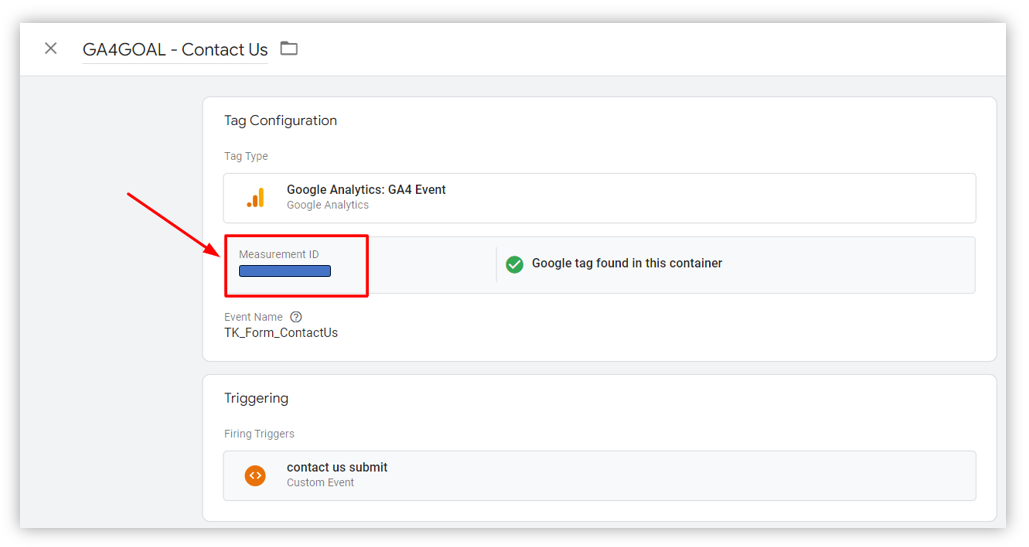
Tag-based conversion tracking relies on Google-generated javascript code snippet(the tag) on your website. When a user completes a conversion action, the tag captures the conversion value and sends it to Google.
c. Offline conversion tracking
It is used to track offline conversion following a user's interaction with your PPC ads. It offers flexibility when assigning a value that aligns with your business objective.
Conclusion
Choosing the right bidding strategy is a crucial decision an advertiser has to make. Smart bidding has become a game-changer strategy that has helped optimize PPC campaigns. Implementing Target ROAS will reap positive results if you apply it while keeping all the factors in mind. If you are a beginner who is looking to implement Target ROAS in a PPC campaign but doesn’t know where to start, you can get in touch with OutsourceSEM. We offer reliable PPC services along with PPC reports, remarketing ads, search ads, video ads, mobile ads, PPC audits, etc. We also provide customized PPC services for home service businesses, including painting PPC, plumbing PPC, construction PPC, appliance repair PPC, and HVAC PPC services.
References:
- Target ROAS in Google Ads: 5 key considerations
- What is Target ROAS in Google Ads & when should I use it?
